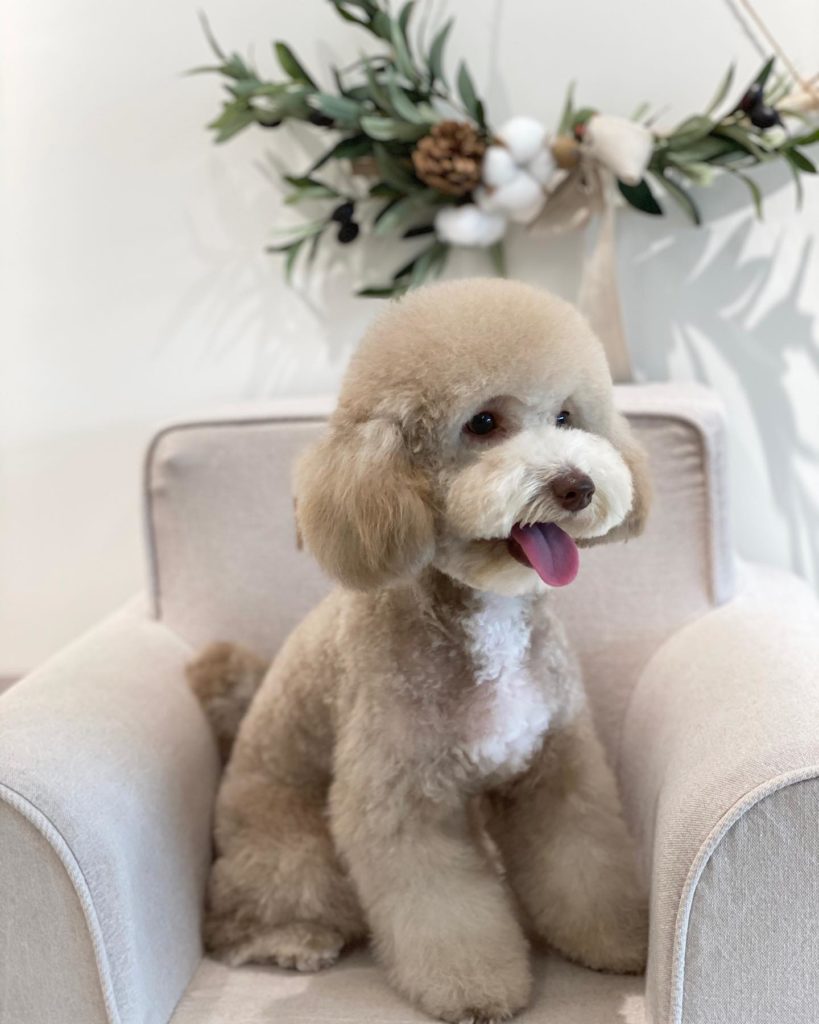Have you ever locked eyes with a poodle whose coat seemed to flawlessly blend multiple hues? A coat that was more than just brown or black, yet not quite another familiar shade?

I was determined to unravel the secrets behind its blended beauty. Only then did I discover café au lait’s subtle notes that set it apart from other poodle furnishings.
Join me as I lift the veil on café au lait and solve the riddle of its unique tonality. Learn what factors play into its blended appearance and how to identify the real café au lait from impersonators. The distinctive qualities of this uncommon shade may surprise even seasoned poodle enthusiasts.

Read our Smart Poodles - Smart Tricks eBook for only $2.99
Dive into a treasure trove of engaging tricks and tips designed specifically for your poodle!
What Will You Learn? 👇
What does a cafe au lait poodle look like?

cafe au lait is a combination of apricot, creamy, and chocolate shades. Puppies are born with dark brown coats, but not beige coats. The color is formed in two years. cafe au Lait is the Poodle breed’s standard color and is included in the AKC breed standards . This is a typical color of the French coffee of the same name, which is characterized by approximately equal shares of coffee and milk. It can be described as a rich, well-saturated light brown color.
Also, the phantom standard poodle has a coat color that may be similar to the cafe au lait, and it may be more suited to your taste.
Cafe au lait and silver beige poodles are very easy to confuse, and it is difficult to determine which of these colors the poodle inherited. The main determining factor is that true cafe au lait poodles are born in their true color, and the silver beige poodle has to fade to achieve its true color. In addition, the mature cafe au lait poodle is also slightly darker in the shade than a silver beige poodle.
The nose of such dogs is always liver-colored, which is a distinctive feature of cafe au lait poodles. The eyes are dark brown, amber, and sometimes reddish-brown. Borders around eyes, lips, and nails are brown; sometimes, the toenails are black. The skin is light pinkish-gray or tan to match lighter hair. It’s worth noting that these dogs may have darker brown ears and even dark brown stripes all over their body, which is a show slip, but breeders generally don’t care.

Maintenance and grooming of cafe au lait poodle
The cafe au lait poodle is an excellent dog in every way. This is an intelligent and beautiful animal that can become your faithful friend. However, if you decide to have such a pet, be prepared to spend a lot of money and a lot of time caring for it. No wonder that the cafe au lait poodle is called the most expensive dog in terms of grooming, especially if the pet participates in exhibitions and competitions.
The very first thing, letting the cafe au lait poodle into the house, show him a place with a couch and teach him the command “place.” If the puppy is allowed on the owner’s bed or sofa, it won’t be easy to wean him from this privilege. To keep your pet from getting bored, buy long-lasting bone toys. Otherwise, when left alone, the dog will gnaw on shoes, furniture, and everything that gets on the tooth. It is important to walk your dog daily. The cafe au lait poodle loves to frolic, so he needs to be given the opportunity to spend the accumulated energy.
In order for the dog to grow up healthy and beautiful, he will need regular hygiene procedures, to which he is taught from puppyhood:
- Once every 13-15 days, you need to clean the auricles. Gently lift the ear flap and use a cotton ball dampened with a vet-approved ear cleaner to wipe away dirt and wax. Wipe from the base of the ear to the tip being careful not to push debris deeper into the ear canal. Check for any signs of inflammation or odor and consult your vet if issues arise. It is recommended to use a special powder during the procedure.
- Train your dog to brush its teeth once a week. It is recommended to buy a soft toothbrush and toothpaste for this procedure.
- The nails are cut approximately every 20-30 days. This is not an easy task; therefore, it is recommended to use the services of a specialist.
- Wipe eyes and nose for signs of inflammation if necessary.
It would be best if you carried out all these procedures in a relaxed atmosphere. Do not yell at your pet if he is not assiduous, and reward if the dog obediently accepts cleaning and inspection.
Caring for a coat requires special attention and a lot of time. In addition to regular combing, haircuts and relatively frequent bathing are also needed.
- Combing: Use a quality slicker brush like the Chris Christensen Grooming Slicker Brush to remove loose hair and distribute skin oils. For mats and tangles, a comb labeled “CC Buttercomb” is perfect for detangling. As an alternative to store-bought sprays, make a DIY leave-in conditioner by mixing 1-2 tablespoons of hair conditioner with a spray bottle of water.
- Bathing: For bath time, a high-quality shampoo is key – Look for pH-balanced formulas without dyes or scents. Earthbath Ultra-Mild Puppy Shampoo is a good option. Make bath time fun by rewarding with treats. As a homemade refresher between baths, add 1/4 cup white vinegar to the rinse cycle to remove odors and moisturize coat.
Moreover, you can be calm, because there will be no problems with water procedures. After all, the cafe au lait poodle loves water. He bathes with pleasure in the bathroom, in the shower, and the natural reservoir. After bathing, the dog should be dried with a towel, then dried with a hairdryer, and at the same time combed through the coat.
- Haircuts: Keep coats neat in between salon visits by DIY-trimming messy paw pads and sanitary areas. Use rounded-tip dog grooming scissors for safety. For a show-quality cut, book an appointment with a professional groomer regularly.
The cafe au lait poodle should eat balanced and quality food. The ration was made considering that the liver of such a dog is very sensitive. Many foods, such as raw fish, smoked meats, rolls, tubular bones, and sweets, are contraindicated. Fatty meat and dairy products with a high percentage of fat content are also prohibited. Fruit, rye bread, and cheese are allowed as a treat. It should be noted that vitamin and mineral supplements and constant access to clean, cool water are needed.
The origin story of the cafe au lait poodle

The café au lait poodle is distinguished by its refined and aristocratic looks. This proud breed has a long history serving as companions to famous artists, writers and royalty throughout Europe. However, the precise origin of the poodle remains unclear.
One theory holds that poodles originated in France. As early as the 12th century, sculptures and paintings from this era depict poodle-like dogs, such as those adorning structures like the Notre Dame Cathedral in Paris built from 1163-1345. The French bred poodles as accomplished water retrievers to support hunting.
Alternatively, some experts trace poodles back to Germany. The first depictions resemble those found in ancient Roman mosaics from the 1st-4th centuries AD. Poodle-type dogs also appear on coins minted in Germany in the 15th-16th centuries.
By the 16th century, poodles had become wildly popular across Europe due their utility, intelligence and charm. Several varieties emerged suited to roles like hunting waterfowl versus companion duties. In the 19th-20th centuries, kennel clubs began formalizing breed standards.
The name “poodle” derives from the German “pudel” or Latin “pulicare”, meaning to splash in water. Highly adept swimmers, poodles helped hunters retrieve game from lakes and streams. Today poodles continue serving important tasks in search and rescue, detection work thanks to their skills, loyalty and trainability.
Share Your Cafe Au Lait Poodle Stories
Do you have experiences to share about owning or interacting with cafe au lait poodles? Their unique blended coats often leave a lasting impression! I’d love to hear any fun anecdotes or case studies about your cafe au lait poodle(s) in the comments below.
By sharing real-life stories, we can help bring the character and charm of cafe au lait poodles to life for others. It also provides a valuable resource for anyone considering the breed. So please feel free to add your poodle tales – the more enriching details, the better! I look forward to reading them.
Marko is the founder and author at PoodleHQ, where he blends profound expertise with formal training in Animal Behavior and Canine Genetics. With multiple generations of poodles under his care, he’s a breed connoisseur, honored with the Canine Care Excellence Award and lauded by the International Pet Enthusiasts Association.


Do you have a register of coffee toy poodle breeders that you recommend, or can you recommend one in the Sydney region.